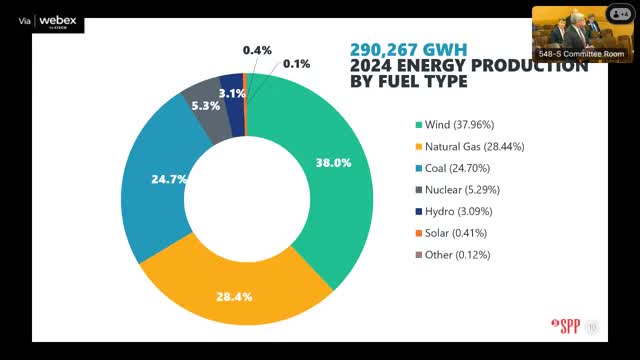Kansas energy sources shift as gas surges past coal reliance
February 06, 2025 | Utilities, Standing, Senate, Committees, Legislative, Kansas
This article was created by AI summarizing key points discussed. AI makes mistakes, so for full details and context, please refer to the video of the full meeting. Please report any errors so we can fix them. Report an error »

The Senate Committee on Utilities meeting held on February 6, 2025, focused on Kansas's energy production and the evolving landscape of fuel sources. A significant highlight was the state's energy generation statistics, revealing that 38% of Kansas's energy last year came from wind, while natural gas accounted for 28%, marking gas as the second-largest fuel source for the first time, surpassing coal, which stood at 24%.
The meeting emphasized the increasing role of natural gas in the state's energy mix, which has seen a 62% rise in generation since 2017. Wind energy has also experienced substantial growth, with an 87% increase over the same period. This shift reflects a broader trend in the energy sector, where coal continues to decline both regionally and nationally, while renewable sources like wind and gas are becoming more prominent.
The committee discussed the importance of Kansas's contribution to the regional energy grid, noting that 51% of the state's energy generation is wind-based. The state's ability to produce more energy than it consumes allows it to participate effectively in a regional market, facilitating the sale and distribution of excess power across multiple transmission lines. This modernized approach contrasts sharply with previous methods that required cumbersome negotiations with multiple transmission owners.
The meeting also touched on the challenges of managing energy production and maintaining reliability, particularly as the state continues to integrate more renewable sources. The committee acknowledged the necessity of adapting to these changes to ensure a stable energy supply for Kansas residents.
Overall, the discussions underscored Kansas's commitment to diversifying its energy portfolio while addressing the challenges posed by the variability of renewable energy sources. The meeting concluded with a recognition of the ongoing investments in emerging technologies, including battery storage, which are expected to play a crucial role in the future of the state's energy landscape.
The meeting emphasized the increasing role of natural gas in the state's energy mix, which has seen a 62% rise in generation since 2017. Wind energy has also experienced substantial growth, with an 87% increase over the same period. This shift reflects a broader trend in the energy sector, where coal continues to decline both regionally and nationally, while renewable sources like wind and gas are becoming more prominent.
The committee discussed the importance of Kansas's contribution to the regional energy grid, noting that 51% of the state's energy generation is wind-based. The state's ability to produce more energy than it consumes allows it to participate effectively in a regional market, facilitating the sale and distribution of excess power across multiple transmission lines. This modernized approach contrasts sharply with previous methods that required cumbersome negotiations with multiple transmission owners.
The meeting also touched on the challenges of managing energy production and maintaining reliability, particularly as the state continues to integrate more renewable sources. The committee acknowledged the necessity of adapting to these changes to ensure a stable energy supply for Kansas residents.
Overall, the discussions underscored Kansas's commitment to diversifying its energy portfolio while addressing the challenges posed by the variability of renewable energy sources. The meeting concluded with a recognition of the ongoing investments in emerging technologies, including battery storage, which are expected to play a crucial role in the future of the state's energy landscape.
View full meeting
This article is based on a recent meeting—watch the full video and explore the complete transcript for deeper insights into the discussion.
View full meeting
